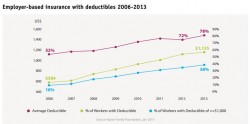 That employers have been shifting the increased cost of health benefits to their employees is hardly news. Now a new study of healthcare use shows just what that means to workers.
That employers have been shifting the increased cost of health benefits to their employees is hardly news. Now a new study of healthcare use shows just what that means to workers.
According to Medicine Use and Shifting Costs of Healthcare: A Review of the Use of Medicines in the United States in 2013, workers today have deductibles 150 percent higher than just five years ago, while nearly 8 in 10 plans have a general deductible of $1,000 or more.
From zero a decade ago, plans with the highest deductible — and the lowest premiums — now account for 20 percent of worker plans. These high-deductible health plans and HSAs have cut deeply into the HMO offerings that accounted for 45 percent of plans in 2004. Now, HMOs and other plans have a 23.5 percent share.
The report compiled by the IMS Institute for Healthcare Informatics says employers have been “actively encouraging” workers to adopt the high-deductible plans, noting “17 percent of employers only offered high deductible plans in 2013, up 31 percent from 2012.”
Coincidentally, out-of-pocket costs for prescription drugs is declining. The Institute found it now averages $5 for about 57 percent of the retail prescriptions filled. Almost a quarter of all prescription meds now have no out-of-pocket.
According to the report’s findings:
- Plans with general deductibles, which can apply to both medical procedures and prescription drugs, now account for 78 percent of plans, and more than half of those plans have a deductible of $1,000 or more.
- 38 percent of employer-sponsored insured workers have a deductible of more than $1,000. That’s almost a four-fold increase since 2006.
Despite these increases in deductibles and plan thresholds, visits to doctors increased 2.7 percent last year, the first increase in four years. The increase was fueled by visits to specialists, which were up 4.9 percent, offsetting the .7 percent decline in visits to primary care doctors. Visits overall, however, are still appreciably below where they were in 2008.
The Institute’s report is a survey of healthcare usage generally, and not specific to employer plans. Much of the report is focused on spending on prescription medicines, which came to $329.2 billion in 2013, a 3.2 percent increase from the previous year. The report also includes data on what types of drugs are being bought, as well as co-pays. There’s data on hospital care as well.